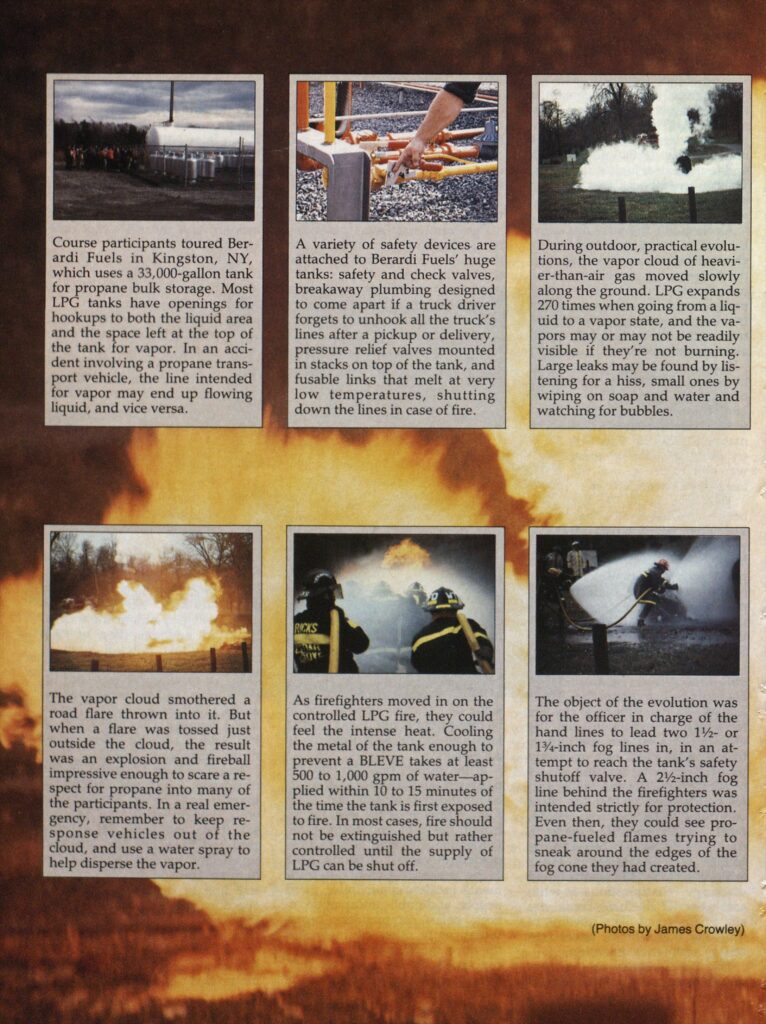


Course participants toured Berardi Fuels in Kingston, NY, which uses a 33,000-gallon tank for propane bulk storage. Most LPG tanks have openings for hookups to both the liquid area and the space left at the top of the tank for vapor. In an accident involving a propane transport vehicle, the line intended for vapor may end up flowing liquid, and vice versa.

A variety of safety devices are attached to Berardi Fuels’ huge tanks: safety and check valves, breakaway plumbing designed to come apart if a truck driver forgets to unhook all the truck’s lines after a pickup or delivery, pressure relief valves mounted in stacks on top of the tank, and fusable links that melt at very low temperatures, shutting down the lines in case of fire.

During outdoor, practical evolutions, the vapor cloud of heavier-than-air gas moved slowly along the ground. LPG expands 270 times when going from a liquid to a vapor state, and the vapors may or may not be readily visible if they’re not burning. Large leaks may be found by listening for a hiss, small ones by wiping on soap and water and watching for bubbles.

The vapor cloud smothered a road flare thrown into it. But when a flare was tossed just outside the cloud, the result was an explosion and fireball impressive enough to scare a respect for propane into many of the participants. In a real emergency, remember to keep response vehicles out of the cloud, and use a water spray to help disperse the vapor.

As firefighters moved in on the controlled LPG fire, they could feel the intense heat. Cooling the metal of the tank enough to prevent a BLEVE takes at least 500 to 1,000 gpm of water—applied within 10 to 15 minutes of the time the tank is first exposed to fire. In most cases, fire should not be extinguished but rather controlled until the supply of LPG can be shut off.

The object of the evolution was for the officer in charge of the hand lines to lead two 1½or 1 3/4-inch fog lines in, in an attempt to reach the tank’s safety shutoff valve. A 2 1/2-inch fog line behind the firefighters was intended strictly for protection. Even then, they could see propane-fueled flames trying to sneak around the edges of the fog cone they had created.
(Photos by James Crowley)
LPG Training
FEATURES
TRAINING

There’s nothing average about a fire that involves liquefied petroleum gas. So firefighters need to learn the basics of LPG handling, prefire planning, fire dynamics, and fireground tactics. This knowledge comes from training like the seminar the New York State Academy of Fire Science at Montour Falls offered in November of 1985.
The course producers enlisted three local instructors—a fire chief, a propane distributor, and a hazardous materials specialist from the state police who is on 24-hour call and responds to all over-the-road haz mat calls in his part of the state.
Propane, stored at subzero temperatures under pressure, can send its containers rocketing several thousand feet if fire changes those storage conditions. It’s this potential for a boiling liquid, expanding vapor explosion, or BLEVE, that makes training so essential.

